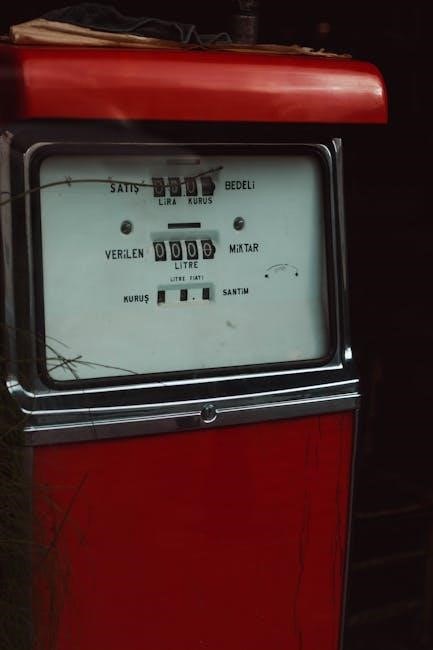TIPM fuel pump relay bypass kits offer a solution to common fuel delivery problems in vehicles. These kits bypass the faulty relay within the TIPM, directly powering the fuel pump. This restores functionality and prevents vehicle stalling or failure to start. Installation can be a cost-effective alternative.

Understanding the TIPM (Totally Integrated Power Module)
The Totally Integrated Power Module, or TIPM, is a critical component in many modern vehicles, acting as the central hub for electrical distribution and control; Think of it as the brain of your car’s electrical system, managing power to various functions, including the fuel pump. The TIPM houses relays and fuses that control these systems, integrating what were previously separate modules into a single unit.
However, the TIPM is a known weak point. A common issue is the failure of the fuel pump relay, often due to internal component degradation or manufacturing defects. When this relay fails, it can interrupt power to the fuel pump, leading to a no-start condition or sudden stalling while driving.
The integrated nature of the TIPM means that replacing the entire unit can be expensive and time-consuming. This is where the fuel pump relay bypass kit comes in. It offers a more targeted and affordable solution by circumventing the problematic relay within the TIPM, providing a dedicated power supply to the fuel pump. Understanding the TIPM’s role and its common failure points is essential for diagnosing fuel pump issues and considering a bypass kit as a viable repair option.
Identifying Fuel Pump Relay Failure Symptoms
Recognizing the symptoms of a failing fuel pump relay within the TIPM is crucial for timely diagnosis and repair. One of the most common signs is a no-start condition. The engine cranks, but fails to ignite due to the fuel pump not receiving power. Intermittent stalling while driving is another telltale symptom. The engine may suddenly cut out, especially under load or at higher speeds, then potentially restart after a period.
Difficulty starting, particularly after the vehicle has been sitting for a while, can also indicate a failing relay. You might experience prolonged cranking before the engine finally starts. A clicking sound emanating from the TIPM area could also be a sign, indicating the relay is attempting to engage but failing. Fuel pump relay issues can also cause decreased fuel efficiency, rough idling, or a lack of power during acceleration.
It’s important to note that these symptoms can also be caused by other issues, such as a failing fuel pump itself. Therefore, proper diagnosis is essential to pinpoint the root cause. If you experience any of these symptoms, consider checking the fuel pump relay within the TIPM or consulting a mechanic for a professional evaluation.
Tools and Materials Needed for Installation
Before beginning the installation of a TIPM fuel pump relay bypass kit, gathering the necessary tools and materials is essential for a smooth and successful process. First and foremost, you will need the TIPM fuel pump relay bypass kit itself, ensuring it is compatible with your specific vehicle make, model, and year. A set of wire strippers and crimpers are crucial for preparing and connecting the wiring of the bypass kit.
You’ll also need a multimeter to test for voltage and continuity, ensuring proper connections and diagnosing any potential issues. A socket set and wrench set will be necessary for accessing the TIPM and securing any mounting hardware. Electrical tape or heat shrink tubing will be needed to insulate and protect the wiring connections, preventing shorts and ensuring long-term reliability.
Additionally, consider having a utility knife or razor blade for carefully trimming wires and removing any necessary components. A screwdriver set, including both Phillips head and flathead screwdrivers, will be useful for various tasks during the installation. Finally, a pair of safety glasses and gloves are recommended to protect yourself during the installation process. Having these tools and materials readily available will streamline the installation and help ensure a safe and effective repair.

Step-by-Step Installation Instructions
Detailed instructions are crucial for installing a TIPM fuel pump relay bypass kit. Follow each step carefully, starting with disconnecting the battery; Locate the fuel pump relay, connect bypass wiring, and test functionality. Ensure proper connections and safety throughout the installation process for optimal results.
Disconnecting the Battery
Before commencing any work on your vehicle’s electrical system, including the installation of a TIPM fuel pump relay bypass kit, disconnecting the battery is a paramount safety precaution. This simple yet crucial step prevents accidental electrical shocks and minimizes the risk of damaging sensitive electronic components. Ensure the ignition is switched off and the keys are removed from the ignition switch before proceeding.
To disconnect the battery, locate the negative terminal, usually marked with a “-” symbol. Use a wrench to loosen the nut securing the cable clamp to the terminal. Once loosened, carefully detach the cable clamp from the negative terminal. Tuck the disconnected cable away from the terminal to prevent accidental contact during the installation process. Repeat this process for the positive terminal, marked with a “+” symbol.
By disconnecting both the negative and positive terminals, you effectively isolate the vehicle’s electrical system, ensuring a safe working environment. This prevents any possibility of short circuits or electrical feedback that could harm you or the vehicle’s components. Remember, safety should always be the top priority when working on any automotive electrical system.
Locating the Fuel Pump Relay in the TIPM
The next crucial step in installing a TIPM fuel pump relay bypass kit involves pinpointing the exact location of the fuel pump relay within the Totally Integrated Power Module (TIPM). The TIPM, often referred to as the fuse box, houses numerous relays and fuses responsible for controlling various electrical functions in your vehicle. Identifying the correct fuel pump relay is essential for a successful bypass kit installation.
Consult your vehicle’s owner’s manual or a reliable online resource to obtain a detailed diagram of the TIPM layout. This diagram will illustrate the position of each relay and fuse, including the fuel pump relay. Typically, the fuel pump relay is labeled or identified with a specific number or code. Once you have located the fuel pump relay on the diagram, carefully examine the TIPM itself;
The TIPM is usually located under the hood, often near the engine or firewall. Remove the TIPM cover to expose the relays and fuses. Compare the physical layout of the relays and fuses with the diagram you consulted earlier. Look for the relay that matches the description and location of the fuel pump relay. Once identified, you are ready to proceed with connecting the bypass kit wiring.
Connecting the Bypass Kit Wiring
With the fuel pump relay located within the TIPM, the next critical step is connecting the bypass kit wiring. Carefully follow the instructions included with your specific bypass kit, as wiring configurations may vary. The general principle involves tapping into the fuel pump circuit to provide an alternative power source, bypassing the faulty relay.
Typically, the bypass kit includes wires with connectors designed to interface with the fuel pump relay socket. Identify the wires in the kit that correspond to the power and ground connections for the fuel pump. Using appropriate wire strippers and crimpers, prepare the ends of the bypass kit wires for connection.
Insert the bypass kit wires into the corresponding terminals of the fuel pump relay socket. Ensure a secure and reliable connection to prevent loose wires or intermittent power issues. Some kits may require you to remove the original fuel pump relay before inserting the bypass kit wires, while others may allow you to leave the relay in place.
Double-check all connections to verify that they are properly seated and securely fastened. Once you are confident in the wiring connections, proceed to the next step, which involves testing the bypass kit functionality.
Testing the Bypass Kit Functionality
After meticulously connecting the bypass kit wiring, it’s crucial to test its functionality. This step ensures that the kit effectively bypasses the faulty fuel pump relay and restores proper fuel delivery to the engine. Before initiating the test, double-check all wiring connections to confirm they are secure and correctly positioned.
Reconnect the vehicle’s battery, ensuring the terminals are properly tightened. Turn the ignition key to the “on” position, but do not start the engine yet. Listen carefully for the sound of the fuel pump priming, which indicates that it is receiving power and building pressure in the fuel system.
If you hear the fuel pump priming, proceed to start the engine. Observe the engine’s behavior closely. It should start smoothly and run without any hesitation or sputtering. If the engine starts and runs normally, the bypass kit is functioning correctly.
If the engine fails to start or exhibits any signs of fuel starvation, such as rough idling or stalling, re-examine the wiring connections and consult the bypass kit’s troubleshooting guide. It may be necessary to retrace your steps and verify that all connections are secure and properly aligned. If problems persist, consider seeking professional assistance from a qualified mechanic.

Safety Precautions During Installation
Prioritizing safety is paramount when installing a TIPM fuel pump relay bypass kit. Working with electrical systems in vehicles requires caution to prevent injury or damage. Before commencing any work, disconnect the negative terminal of the vehicle’s battery. This prevents accidental electrical shocks and protects the vehicle’s electrical components.
Always wear appropriate personal protective equipment (PPE), including safety glasses and gloves. Safety glasses shield your eyes from debris, while gloves protect your hands from sharp edges or potentially harmful substances. Work in a well-ventilated area to avoid inhaling fumes or vapors from fuel or cleaning agents.
Ensure the vehicle is parked on a level surface and the parking brake is engaged to prevent accidental movement. Keep a fire extinguisher nearby in case of a fire. If you are unfamiliar with automotive electrical systems, seek assistance from a qualified mechanic. Improper installation can lead to electrical damage or fire hazards.
Carefully read and understand all instructions provided with the bypass kit before starting the installation. Follow the instructions precisely and do not deviate from the recommended procedures. If you encounter any difficulties or uncertainties, stop and consult the instructions or seek professional help. Rushing through the installation or taking shortcuts can compromise safety and lead to improper functionality.

Troubleshooting Common Issues After Installation
After installing a TIPM fuel pump relay bypass kit, some issues may arise. If the fuel pump fails to activate, check all wiring connections. Ensure they are secure and properly connected according to the kit’s instructions. Verify the bypass relay is functioning correctly by testing it with a multimeter. A blown fuse in the bypass circuit can also prevent fuel pump operation; inspect and replace any damaged fuses.
If the vehicle starts but runs poorly, the fuel pump may not be receiving adequate voltage. Check the voltage at the fuel pump connector with a multimeter to ensure it meets the manufacturer’s specifications. A faulty ground connection can also cause performance issues. Inspect and clean all ground connections associated with the fuel pump and bypass kit.
Inconsistent fuel delivery can result from a partially blocked fuel filter or a failing fuel pump. Consider replacing the fuel filter and inspecting the fuel pump for signs of wear or damage. If the vehicle exhibits intermittent starting problems, the bypass relay may be overheating. Relocate the relay to a cooler location or use a heat shield to protect it.
If problems persist, consult a qualified mechanic for further diagnosis. They can use specialized tools and diagnostic equipment to identify and resolve any underlying issues. Remember that electrical troubleshooting requires caution, so take necessary safety precautions.
Is a TIPM Bypass a Permanent Fix?
A TIPM fuel pump relay bypass kit offers a practical solution to a common problem, but its permanence is often debated. While it effectively circumvents the faulty relay within the TIPM, it doesn’t address the root cause of the TIPM failure. The bypass essentially provides an alternative power source for the fuel pump, ensuring its operation despite the TIPM’s internal issues. This can restore vehicle functionality and prevent stalling.
However, the long-term reliability of a bypass depends on various factors. The overall condition of the TIPM and the quality of the bypass kit play significant roles. If the TIPM has other underlying problems, such as corrosion or failing components, these issues may eventually lead to further complications. Similarly, a poorly designed or installed bypass kit can introduce new points of failure.
For many, a TIPM bypass serves as a cost-effective and convenient solution, extending the life of their vehicle. Some users have reported driving thousands of miles with a bypass kit installed. However, it’s essential to recognize that it’s not a comprehensive repair of the TIPM itself.
Consider it a practical workaround that can provide years of reliable service, but monitoring the vehicle for any new or recurring issues is advisable. If long-term peace of mind is a priority, replacing the entire TIPM might be the more permanent solution.
